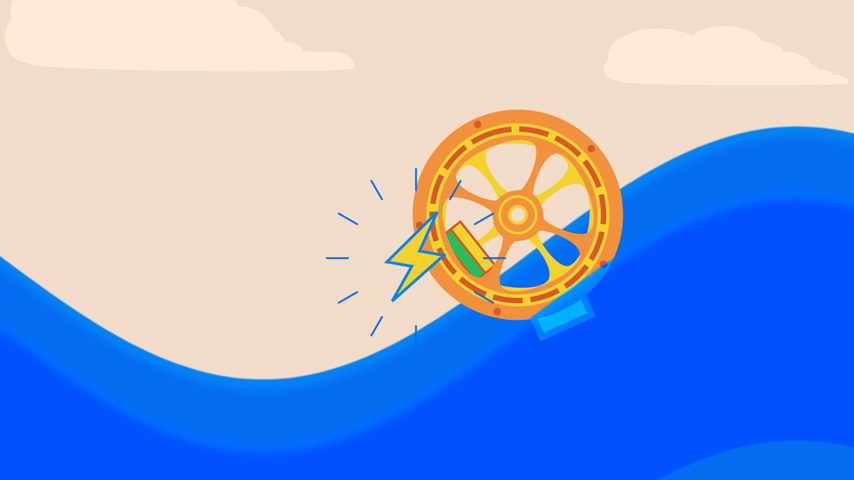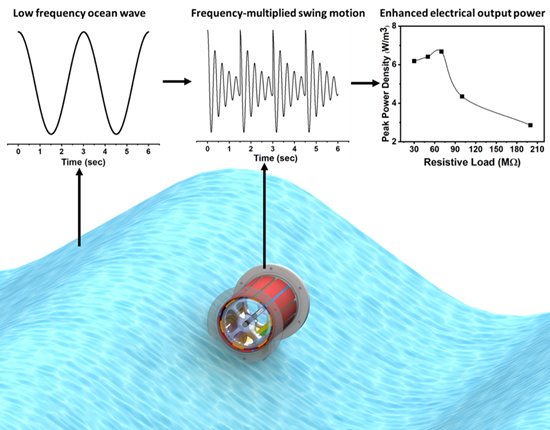Fur-Lined Barrels Turn Ocean Swells to Electricity
Fur-Lined Barrels Turn Ocean Swells to Electricity


A tiny barrel within a barrel turns ocean swells into electricity.
Anyone who’s rubbed a balloon back and forth across their hair so it will stick to a wall, floating, without the aid of helium, knows the power of triboelectricity. The stuff shows up whenever two things create friction against each other—be it latex on hair, rubber soles on carpet, the seat of the pants on a slide, or any other material on any other material—and then come apart. Now, thanks to researchers out of Pacific Northwest National Laboratory, the effect is poised to power more than finger shocks and party tricks.
They’ve created a TENG, or triboelectric nanogenerator, that takes its power from waves and creates enough electricity to run water quality sensors or satellite communications from the middle of the ocean. And it has the potential to power much more.
The device PNNL created is essentially a cylinder inside a cylinder. The outside of the inner cylinder and the inside of the outer cylinder are both covered with dielectric material (fur, basically), which creates a charge when the cylinders turn, and the materials rub against each other.
Throw such a device in the sea and the waves found there will toss it about and make the cylinders spin, slowly producing a trickle of electricity. That trickle would be too small to power anything of actual use. But now Zhiqun (Daniel) Deng, a laboratory fellow in the Energy Environment Directorate at PNNL, where he is the director of the Bio-Acoustics & Flow Laboratory, has found a way to get more juice from the rise and fall of waves using a TENG.
Become a Member: How to Join ASME
His team’s innovation is to add magnets, one on the rotor (the inside cylinder) and one on the stator (the outside cylinder). With the added mass, and the magnetism, the magnets keep the cylinders from moving against each other. They stay locked in place until they are close to the crest of a wave. Then the angular momentum of the TENG is strong enough to break the magnetic force and the cylinder spins suddenly. “For the whole cycle it doesn’t rotate much,” explained Deng. “It only rotates for a small fraction of a wave. But because it rotates very fast, it actually generates electricity more efficiently.”
This first iteration of Deng’s concentric cylinder system produces something in the order of milliwatts. That’s enough to power some ocean sensors that could be strewn about the seas to report back remotely. But Deng has bigger dreams. “The ultimate goal, of course, is larger scale power production,” he said. “But there’s a long way to go.”
“We want to make sure they can actually last in the harsh environment for a reasonable time when we scale from an ideal environment to a more realistic environment,” said Deng. “But we are optimistic.”
Michael Abrams is a technology writer in Westfield, N.J.
They’ve created a TENG, or triboelectric nanogenerator, that takes its power from waves and creates enough electricity to run water quality sensors or satellite communications from the middle of the ocean. And it has the potential to power much more.
The device PNNL created is essentially a cylinder inside a cylinder. The outside of the inner cylinder and the inside of the outer cylinder are both covered with dielectric material (fur, basically), which creates a charge when the cylinders turn, and the materials rub against each other.
Throw such a device in the sea and the waves found there will toss it about and make the cylinders spin, slowly producing a trickle of electricity. That trickle would be too small to power anything of actual use. But now Zhiqun (Daniel) Deng, a laboratory fellow in the Energy Environment Directorate at PNNL, where he is the director of the Bio-Acoustics & Flow Laboratory, has found a way to get more juice from the rise and fall of waves using a TENG.
Become a Member: How to Join ASME
His team’s innovation is to add magnets, one on the rotor (the inside cylinder) and one on the stator (the outside cylinder). With the added mass, and the magnetism, the magnets keep the cylinders from moving against each other. They stay locked in place until they are close to the crest of a wave. Then the angular momentum of the TENG is strong enough to break the magnetic force and the cylinder spins suddenly. “For the whole cycle it doesn’t rotate much,” explained Deng. “It only rotates for a small fraction of a wave. But because it rotates very fast, it actually generates electricity more efficiently.”
This first iteration of Deng’s concentric cylinder system produces something in the order of milliwatts. That’s enough to power some ocean sensors that could be strewn about the seas to report back remotely. But Deng has bigger dreams. “The ultimate goal, of course, is larger scale power production,” he said. “But there’s a long way to go.”
More for You: Infographic: Harnessing the Waves
For one thing, Deng’s TENG has, so far, only done its thing in a wave tank at the lab. The little centimeters-wide cylinders haven’t been tested in the big, bad, caustic, real world. As one of the main attractions of the wave generator is that it will be cheap and easy to deploy, making it robust and long-lasting represents a significant challenge. “Efficiency and reliability—that’s the next battle,” said Deng. Right now, he and his team are working on finding the best solutions to connecting TENGs and sensors for electricity delivery.“We want to make sure they can actually last in the harsh environment for a reasonable time when we scale from an ideal environment to a more realistic environment,” said Deng. “But we are optimistic.”
Michael Abrams is a technology writer in Westfield, N.J.




